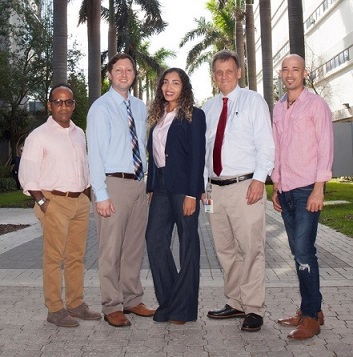Military Burn
Modulation of Burn Scars Through Laser Assisted Delivery of Stem Cells



Posted January 2, 2018
Evangelos Badiavas, M.D., Ph.D., University of Miami School of Medicine

From left to right: Luis Rodriguez-Menocal, Ph.D., Jeffery McBride, M.D., Ph.D., Ambar Candanedo, M.S., Evangelos Badiavas, M.D., Ph.D., and Wellington Guzman, M.S.
Burn patients with second-degree, deep-dermal, full thickness burns often undergo multiple operations. Post-burn scars present significant problems that limit an individual's ability to perform basic tasks due to inefficient thermal regulation as well as limited flexibility and range of motion due to scar contractures forming at the joints. Current treatments and experimental therapies to mitigate the effects of hypertrophic scars include scar massage, topical treatments, steroid injections, and compression garments, but these have had limited impact. To address the morbidity of burn scars in the injured Warfighter, the Military Burn Research Program (MBRP) has invested in several research projects focused on developing novel treatment options ranging from the prevention/mitigation of the effects of burn scars to reducing morbidity of post-burn scar contracture.
A research team led by Evangelos Badiavas, which included Steve Davis, Robert Christy, others from the University of Miami School of Medicine, and the U.S. Army Institute of Surgical Research, received Fiscal Year 2011 funds from the MBRP to develop an optimal delivery system using stem cells in the reduction of burn scars. The researchers used a Duroc pig model of third-degree thermal burns to investigate the use of laser therapy both alone and as an adjunctive therapy to co-deliver stem cells for the mitigation of hypertrophic scars. After burn scars were developed for 70 days on the backs of the pigs, each scar received either carbon dioxide (CO2) laser treatment or Erbium:YAG ablative fractional laser treatment, both with and without the co-delivery of stem cells. The delivered stem cells were either allogeneic (from another pig) or autologous (from the same pig) adipose stem cells, or they were bone marrow-derived mesenchymal stem cells. Biopsy samples were taken from burn scars at various days post-treatment for evaluation of (1) the cells and tissues, (2) expression of certain proteins, and (3) cell culture analysis. Both lasers alone appeared to modulate hypertrophic burn scars, with the Erbium:YAG laser treatment producing an overall better clinical appearance (See Figure 1). Interestingly, the deeper channels created by lasers, particularly by CO2, at higher settings, appeared to limit the ability to deliver the stem cells. The research team hypothesizes that this may be caused by thermal-induced coagulation observed in the deeper channels.
It is also likely that the high levels of ablative fractional laser energy produce a debridement effect on scars that is beneficial to wound healing. While data seem to show that autologous stem cells in combination with Eribium:YAG laser can treat hypertrophic burn scars, results also indicate that repeat administration could further improve the scar modulation. The research team also studied stem cells embedded in PEGylated gels to determine whether this delivery matrix would prolong the effect of the stem cells on treated scars (Figure 2). Results show that application of the gel after laser therapy caused a reduction in scar size and inflammation, suggesting that this method exerts an extended paracrine response.
The study team hopes to use this data and more as justification for moving this potential therapy into humans in the future. If successful, laser-delivered stem cells could one day be used to treat burn scars, helping to mitigate and eliminate scar contractures for persons living with debilitating burn scars.
The data and results from this project are being prepared for publication, and have been presented at national and international meetings such as the Military Health System and Research Symposium, at which it won 1st place in the 2015 Poster Session 3.
Last updated Friday, December 13, 2024















